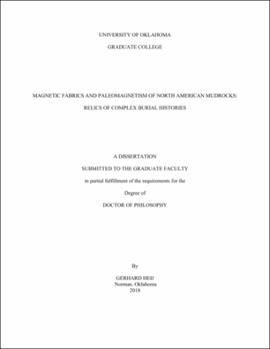| dc.contributor.advisor | Elmore, Richard | |
| dc.contributor.author | Heij, Gerhard | |
| dc.date.accessioned | 2018-12-10T16:05:21Z | |
| dc.date.available | 2018-12-10T16:05:21Z | |
| dc.date.issued | 2018-12-14 | |
| dc.identifier.uri | https://hdl.handle.net/11244/316294 | |
| dc.description.abstract | Rock fabrics have long been recognized as a key variable influencing unconventional reservoir properties and yet, petrofabric analysis is rarely incorporated in reservoir characterization in a quantitative and scalable manner. This work introduces anisotropy of magnetic susceptibility (AMS) coupled with hand-held x-ray fluorescence (HHXRF) to define the origin of petrofabrics in the Wolfcamp Formation and examine their relationship with total organic carbon (TOC) and oil saturation indices (OSI). Standard paleomagnetic plugs were drilled from three vertical cores spanning the entire Wolfcamp Formation in the Midland Basin, West Texas. Low temperature magnetic experiments suggest paramagnetic minerals contribute between 93.4-98.6% of the low-field bulk magnetic susceptibility (klf) across all lithotypes. Scanning electron microscopy revealed frequent occurrences of paramagnetic minerals such as chlorite, illite, ferroan dolomite, marcasite and pyrite. Fe-rich clays such as chlorite carry the AMS signal in mudrocks with a minor contribution from ferroan dolomite. Conversely, ferroan dolomite carries the AMS signal in most carbonate facies with a minor influence from Fe-rich clays. The degree of magnetic anisotropy (Pj) and shape factor (T) in mudrocks are compositionally dependent and respond to changes in both clay and framework grain concentration. For carbonate facies, Pj and T vary widely due to changes in depositional facies and the concentration of ferroan dolomite.
TOC strongly correlates with Pj and strongly oblate magnetic fabrics. This relationship likely stems from the adsorption of organic matter (OM) to clays during deposition and may indicate that organoclay composites were responsible for delivering OM to the sediment-water interface. Elevated OSI are fabric selective, favoring low Pj and T fabrics suggesting that such fabrics facilitate hydrocarbon migration more so than high Pj and T fabrics. Fuzzy-c means clustering provides a framework to describe AMS and geochemical transitions at the core scale and could serve as a tool to map barriers and pathways to hydrocarbon migration.
Finally, Ti/Nb and klf data points to a mafic provenance lithotype and suggests layered-intrusive complexes in the Central Basin Uplift were exposed and eroded during deposition of the Wolfcamp Formation. Mafic source rocks likely increased the supply of micronutrients such as dissolved iron and may have enhanced productivity in the Midland Basin. | en_US |
| dc.language | en_US | en_US |
| dc.subject | Wolfcamp Shale | en_US |
| dc.subject | Antrim Shale | en_US |
| dc.subject | Anisotropy of Magnetic Suceptibility | en_US |
| dc.subject | Chemical Remanent Magnetization | en_US |
| dc.title | MAGNETIC FABRICS AND PALEOMAGNETISM OF NORTH AMERICAN MUDROCKS: RELICS OF COMPLEX BURIAL HISTORIES | en_US |
| dc.contributor.committeeMember | Dulin, Shannon | |
| dc.contributor.committeeMember | Sondergeld, Carl | |
| dc.contributor.committeeMember | Roger, Slatt | |
| dc.contributor.committeeMember | Ferre, Eric | |
| dc.date.manuscript | 2018-12-08 | |
| dc.thesis.degree | Ph.D. | en_US |
| ou.group | Mewbourne College of Earth and Energy::Conoco Phillips School of Geology and Geophysics | en_US |
